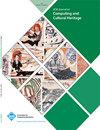Exploring digital means to engage visitors with Roman culture: Virtual Reality vs. Tangible Interaction.
IF 2.2
3区 计算机科学
Q3 COMPUTER SCIENCE, INTERDISCIPLINARY APPLICATIONS
引用次数: 0
Abstract
To effectively communicate the archaeological remains of the distant past is a challenge: little may be left to see, and the culture may be very different to comprehend. This paper compares two technological approaches to communicating Roman archaeology in museums: virtual reality and tangible interaction. Although very different in rationale, design, and implementation, the two explorative studies have the same aim of engaging visitors with important exhibits. The challenge is to effectively communicate the exhibit's original and cultural context. In ‘Views of the Past’ virtual reality was used to support an environmental narrative experience where fragments of history are found scattered in the 3D reconstructed forum of Augustus in Rome. In ‘My Roman Pantheon’, a tangible interactive installation, visitors act as Romans living along Hadrian's Wall making offering to the deities of the Roman pantheon in order to secure their protection. In both explorative studies the combination of the features (virtual reality + narratives, tangible + acting) make visitors feel ‘cultural presence’ where the perception of a place is combined with the awareness of the culture and an understanding of the past. Although they work on very different sensorial reaction (sight for virtual reality, touch for tangible interaction), both are promising mechanisms to design effective visitor's experiences for challenging cultural heritage settings.探索数字手段吸引游客与罗马文化:虚拟现实vs有形互动。
有效地传达遥远过去的考古遗迹是一项挑战:留下的东西可能很少,文化可能与理解非常不同。本文比较了在博物馆中传播罗马考古的两种技术方法:虚拟现实和有形互动。尽管在基本原理、设计和实施上有很大的不同,但这两项探索性研究的目的是相同的,即通过重要的展品吸引游客。挑战在于有效地传达展览的原始和文化背景。在“过去的观点”中,虚拟现实被用来支持一种环境叙事体验,在罗马奥古斯都的3D重建广场上发现了散落的历史碎片。在“我的罗马万神殿”这个有形的互动装置中,游客扮演住在哈德良长城边的罗马人,向罗马万神殿的神供奉祭品,以获得他们的保护。在这两项探索性研究中,特征的结合(虚拟现实+叙事,有形+表演)使游客感受到“文化存在”,其中对一个地方的感知与文化意识和对过去的理解相结合。虽然它们的感官反应非常不同(视觉用于虚拟现实,触觉用于有形互动),但它们都是有希望的机制,可以为具有挑战性的文化遗产设置设计有效的游客体验。
本文章由计算机程序翻译,如有差异,请以英文原文为准。
求助全文
约1分钟内获得全文
求助全文
来源期刊

ACM Journal on Computing and Cultural Heritage
Arts and Humanities-Conservation
CiteScore
4.60
自引率
8.30%
发文量
90
期刊介绍:
ACM Journal on Computing and Cultural Heritage (JOCCH) publishes papers of significant and lasting value in all areas relating to the use of information and communication technologies (ICT) in support of Cultural Heritage. The journal encourages the submission of manuscripts that demonstrate innovative use of technology for the discovery, analysis, interpretation and presentation of cultural material, as well as manuscripts that illustrate applications in the Cultural Heritage sector that challenge the computational technologies and suggest new research opportunities in computer science.
 求助内容:
求助内容: 应助结果提醒方式:
应助结果提醒方式:


